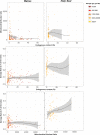Predicting sample success for large-scale ancient DNA studies on marine mammals
- PMID: 33463014
- PMCID: PMC8248401
- DOI: 10.1111/1755-0998.13331
Predicting sample success for large-scale ancient DNA studies on marine mammals
Abstract
In recent years, nonhuman ancient DNA studies have begun to focus on larger sample sizes and whole genomes, offering the potential to reveal exciting and hitherto unknown answers to ongoing biological and archaeological questions. However, one major limitation to such studies is the substantial financial and time investments still required during sample screening, due to uncertainty regarding successful sample selection. This study investigates the effect of a wide range of sample properties including latitude, sample age, skeletal element, collagen preservation, and context on endogenous content and DNA damage profiles for 317 ancient and historic pinniped samples collected from across the North Atlantic and surrounding regions. Using generalised linear and mixed-effect models, we found that a range of factors affected DNA preservation within each of the species under consideration. The most important findings were that endogenous content varied significantly within species according to context, the type of skeletal element, the collagen content and collection year. There also appears to be an effect of the sample's geographic origin, with samples from the Arctic generally showing higher endogenous content and lower damage rates. Both latitude and sample age were found to have significant relationships with damage levels, but only for walrus samples. Sex, ontogenetic age and extraction material preparation were not found to have any significant relationship with DNA preservation. Overall, skeletal element and sample context were found to be the most influential factors and should therefore be considered when selecting samples for large-scale ancient genome studies.
Keywords: DNA damage; aDNA; endogenous content; pinnipeds; sample age; seal; walrus; zooarchaeology.
© 2021 The Authors. Molecular Ecology Resources published by John Wiley & Sons Ltd.
Figures






References
-
- Adler, C. J. , Haak, W. , Donlon, D. , & Cooper, A. The Genographic Consortium . (2011). Survival and recovery of DNA from ancient teeth and bones. Journal of Archaeological Science, 38(5), 956–964.
-
- Ahlgren, H. , Bro‐Jørgensen, M. H. , Glykou, A. , Schmölcke, U. , Angerbjörn, A. , Olsen, M. T. , & Lidén, K. (2021). The Baltic grey seal – a history of presence and absence. DiVA. https://www.diva‐portal.org/smash/record.jsf?pid=diva2%3A1520009&dswid=‐598
-
- Allentoft, M. E. , Collins, M. , Harker, D. , Haile, J. , Oskam, C. L. , Hale, M. L. , Campos, P. F. , Samaniego, J. A. , Gilbert, M. T. P. , Willerslev, E. , Zhang, G. , Scofield, R. P. , Holdaway, R. N. , & Bunce, M. (2012). The half‐life of DNA in bone: Measuring decay kinetics in 158 dated fossils. Proceedings of the Royal Society of London B: Biological Sciences, 279, 4724–4733. - PMC - PubMed
-
- Ambrose, S. H. (1990). Preparation and characterization of bone and tooth collagen for isotopic analysis. Journal of Archaeological Science, 17(4), 431–451.
MeSH terms
Substances
Grants and funding
- Joint Proxies Research Group, financed by Research Council of Norway (RCN) Grant Number 246899 and Faculty for Humanities, Social Sciences and Education, UiT The Arctic University of Norway
- 2015-02151/Swedish Research Council, Sweden
- #676154/European Union's Framework Programme for Research and Innovation Horizon 2020
LinkOut - more resources
Full Text Sources
Other Literature Sources

